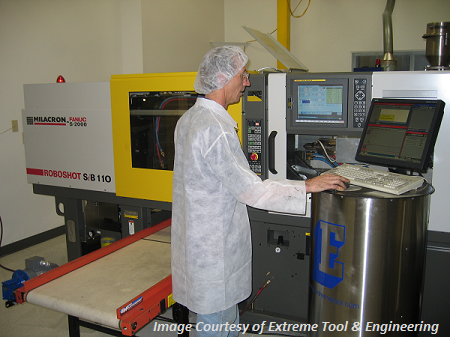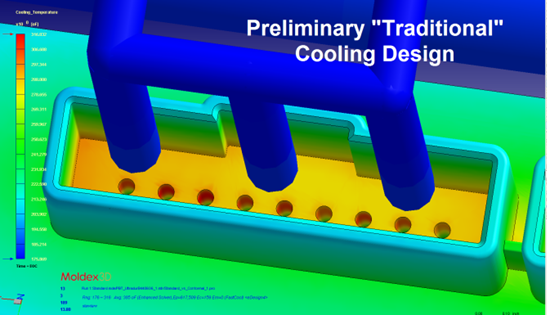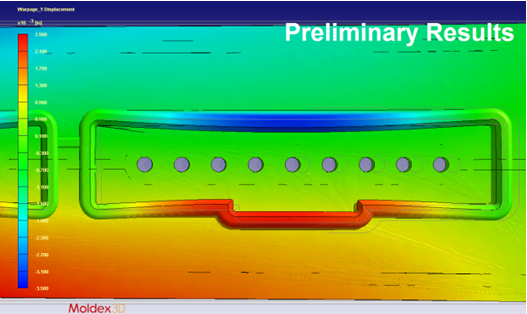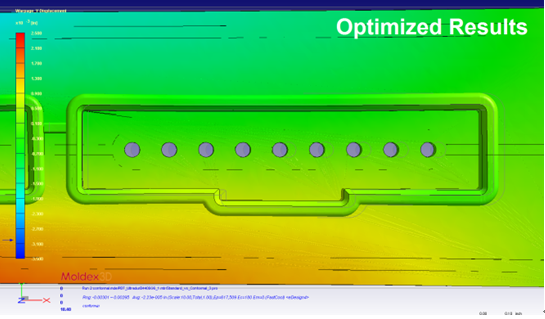Customer Profile
 Extreme Tool & Engineering has grown from the 6 original employees in 1998 to over 70 in 2012, with two facilities located in Wakefield, Michigan. Extreme Tool & Engineering is dedicated to providing turnkey mold making solutions to clients that require lead-time sensitive, complex tooling with full validation and process development, start to finish, all under one roof.
Extreme Tool & Engineering has grown from the 6 original employees in 1998 to over 70 in 2012, with two facilities located in Wakefield, Michigan. Extreme Tool & Engineering is dedicated to providing turnkey mold making solutions to clients that require lead-time sensitive, complex tooling with full validation and process development, start to finish, all under one roof.
Having an in house molding facility with eight molding machines, ranging from 28 to 550 tons, and a state of the art Quality Control Lab, allows Extreme Tool & Engineering to perform FAI, CPK, SPC and PPAP studies on the tooling before it is shipped. This, coupled with an on-site Engineering department, full manufacturing facility with automated machining cells, and 10 journeyman tool makers, allows Extreme Tool and Engineering to produce quality tooling, that makes fully validated quality parts when the tooling arrives at a client’s facility.
In 2007, Extreme Tool & Engineering invested in Moldex3D eDesign. Since, Extreme Tool has been focused on utilizing Moldex3D eDesign to develop a virtual molding process following similar principles to those taught by RJG Inc, the same principles that are then used to develop the real process during tool validation.
Moldex3D gives us the ability clearly identifies part design and tool designs issues during the preliminary design phase. We can optimize and correct these issues long before plastic is ever shot in a new mold, said Bob Sikonia, Engineering Manager at Extreme Tool & Engineering.
Challenges
Injection molded electrical connectors have unique challenges. Resins chosen are often glass filled to aid in rigidity of the part and with multiple inserted terminals having to assemble together smoothly, clearances between the mating parts require tight tolerances.
Solutions
Extreme Tool & Engineering deployed Moldex3D eDesign injection molding software to target areas of concern and optimize designs to build tools accordingly so that real problems can be solved with virtual samples before the tool is even built, which saves the time and money that would be required to address these problems after the first sample.
Benefits
- Reduce deformation and meet product dimension tolerance.
- Target the potential manufacturing defects before the real production, saving money and getting products to market faster.
- True 3D simulation technology accurately validates proposed design iterations, helping identify the optimal design to eliminate potential defects.
Case Study
In this example, an area of concern (Fig.1) was identified with excessive deformation in a critical area of the part, and a cooling design was developed that reduced the deformation to acceptable levels.
A more traditional and less costly manufacture baffle design was first proposed. When reviewing the results of the preliminary cooling design, an excessive amount of “box†warp was detected in the connector interface areas of the part. The predictions showed warp that would not be acceptable and would require a great deal of effort to fix after the first tool sample.Â
       Â
    
Fig. 1  Preliminary traditional cooling design and its analysis result, which showed excessive warping will be unacceptable.
Next, a more sophisticated conformal cooling design was proposed and simulated to determine if the warp condition could be improved. Results show that the warp is reduced to the point where the part will remain in tolerance. Though the manufacturing cost increases in using the conformal approach, when deemed necessary, the conformal approach can provide superior cooling and reduce warp in difficult areas of a part, saving money in the long run by reduced effort grooming the tool into tolerance.
 Â Â Â
   
Fig. 2 Â Optimized conformal cooling design and its analysis result, which showed significantly improved warp condition.
By utilizing the accurate simulation technology of Moldex3D eDesign, critical dimensions can be measured from a virtually deformed part and compared to the tolerance for that given dimension. This virtual inspection is a clear and direct way to increase confidence that a tool design is going to meet the quality requirements of the molded part. Below: Measurement of the deformed part coinciding with the nominal part print dimension of .3080″ +/- .002″ clearly indicates the weakness of the preliminary design and provides confirmation that the proposed conformal design has improved the warp condition to an acceptable level.
Confidence in the Input Gives Confidence in the Output
The results of computer simulations of injection process increase the confidence that the process parameters that are input into eDesign are as close as possible to the process that will be developed during validation. By selecting Moldex3D eDesign, Extreme Tool & Engineering can ensure that potential manufacturing problems are detected before they become real problems, and which has helped the company gain strong confidence in producing tool design that will meet quality requirements.
Drum Mower,Pto Drum Mower,Drum Mower Prices,Drum Mower For Tractor,Disc Mower,Rotor Mower
Changzhou Kafurter Machinery Co., Ltd , https://www.kafurter.com